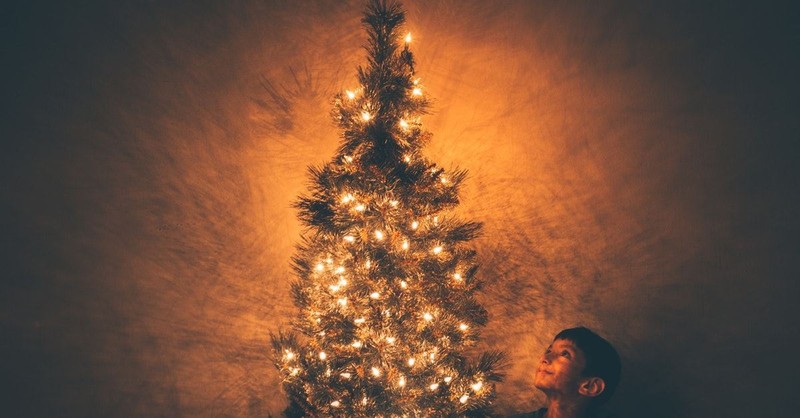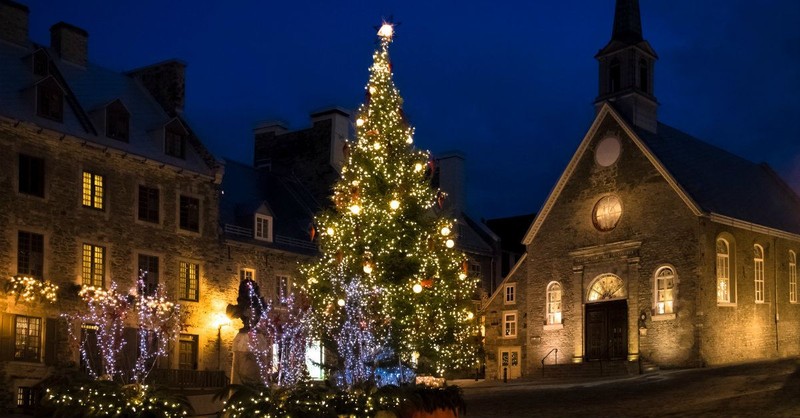
As the holidays get closer, more and more decorated Christmas trees can be seen twinkling through the windows of homes across America. For generations, adorning the tree has been a holiday tradition for families across many nations. But how did this tradition begin? How does the evergreen represent the Christian tradition?
Where did the tradition of the Christmas tree begin and does it have a pagan origin?
Photo Credit: © Unsplash/Mike Blank

Ancient Pagan Origins
In the ancient Egyptian tradition, many celebrations occurred around the time of the Winter Solstice, which is the shortest day and the longest night of the year. The Egyptians believed that this was when the sun god, Ra returned in strength. The solstice symbolized a time of renewal and hope. To celebrate, the people filled their homes with evergreen boughs. They chose the evergreen trees because they maintained their color throughout the harsh winter months. Other people groups, including Roman and Celtic cultures, hung evergreens during the Winter Solstice in celebration, and to keep away evil spirits and illness.
The Tradition Evolves
Most historians believe Christmas trees originated from a guild in Freiburg, Germany, who decorated evergreen trees with fruit, tinsel, wafers, and gingerbread to perform “Paradise Plays” on Christmas Eve. These plays celebrated the story of Adam and Eve. In the 16th century, the plays were banned from public in many places, which corresponds with the time in which Christians first began to bring evergreen trees into their homes to celebrate Christ. Families who could not afford decorated trees simply stacked wood in celebration. These “Christmas pyramids” evolved into wooden shelves holding figurines, candles, and even a star. Eventually, the paradise tree and Christmas pyramid merged to become the modern Christmas tree. The tradition remained in Germany until the 19th century, when people began emigrating from Germany.
Photo Credit: SWN

Christmas Tree Legends
There are several legends associated with how Christmas trees came into existence. The first comes from the English monk Boniface. In the eighth century, Germanic pagans were making sacrifices to the Greek god, Thor. The Benedictine monk cut down the oak tree where the sacrifices were taking place and converted the idolaters to Christianity. According to the legend, a fir tree grew from the fallen oak. The evergreen represented the image of God and new life in Christ.
Another legend of the Christmas tree stems from Martin Luther. Some believe the Protestant revolutionary started lighting candles in trees after walking through the woods on a snowy night. The sight of the moon hitting the snow-glistened trees reminded him of the light of Christ that came down from Heaven. It is also from this experience that inspired him to pen the lyrics to the 1535 Christmas hymn, “From Heaven Above to Earth I Come.”
Until the mid-nineteenth century, the Christmas tree was seen as a primarily pagan tradition in the United States. The early Puritan settlers did not accept the German tradition initially because of its cultic roots. In 1659, a law was established in Massachusetts outlawing the celebration of Christmas, with the exception of church attendance. Hanging decorations of any kind was outlawed, especially on Christmas trees. As more German immigrants entered America, the tradition became more accepted.
In 1848, the London News published an image of Queen Victoria and Prince Albert with their family celebrating around their decorated tree. This photo and its reprints in America popularized the modern idea of the Christmas tree, with its glistening lights, shiny bobbles, and awaiting presents.
Since the 19th century, Americans have embraced the evergreen tree as an annual staple to Christmas cheer. The lighting of the tree in Rockefeller center, as well in other hometowns often symbolizes the beginning of the holiday season.
Photo Credit: © Getty Images/Diego Grandi

What Does the Christmas Tree Symbolize in Christianity?
When you think of Christmas Day, one of the first images that comes to mind is the Christmas tree. But what is the religious significance? While there is no overt reference to an evergreen treen in relation to the actual birth story of Christ, believers have attached religious meaning to the once pagan symbol.
The Choice of the Evergreen – The evergreen tree is a tree that maintains its color throughout the year. Even in the depths of winter, the evergreen tree shows its life. This characteristic of everlasting life represents the life we have in Christ (John 3:16).
The Shape of the tree – The triangular shape of the Christmas tree has often been used to reference the Holy Trinity (Matthew 28:18-19). The upward pointing branches often symbolize our praise to God.
The Lights on the tree – For many Christians, candles or lights on the tree signify how Jesus came as the light into the world. The star placed atop the tree represents the star the wise men followed to Bethlehem (Matthew 2:9).
Presents Under the tree – For some, presents under the tree represent the gifts the wise men brought to Jesus (Matthew 2:11). For others, the presents represent the gift of salvation we have through Jesus (Romans 3:21-22).
The Cutting of the Tree – When the evergreen tree is cut, it is struck down to its death, only to be raised to glory in splendor as a decorated Christmas tree. This transformation of the tree symbolizes how Jesus died on a tree and was raised to new life on the third day.
Photo Credit: © Getty Images/Gyro

Should Christians Have Christmas Trees in Their Homes?
While most people never really think about the history or the practice of putting up a Christmas tree, some Christians do not celebrate the season with an evergreen. Here are a few reasons why.
- Jeremiah 10:1-5 – In this passage of Scripture, the Lord speaks through the prophet and tells the people to not adhere to the idolatrous practice of cutting down trees and decorating them with gold and silver.
- Pagan Historical Associations – Some families do not place Christmas trees in their home because of the pagan origins. They instead opt for other decorations, such as a nativity to remind them of the birth of Christ.
- Distraction from Jesus – Some Christians do not place a tree in their home because the gifts and glamour take away from the celebration of the birth of Jesus.
If we take an honest look at the tradition of the Christmas tree, the roots and religious symbolism is not overwhelmingly representative of the birth of Christ. Yet, the biblical arguments against it are not vast either. The principle derived from Jeremiah 10:1-5 is to not participate in idolatry. The cultural practice of the passage happened to be the cutting and decorating of trees.
Ultimately, the choice to celebrate with a Christmas tree during the holidays is a personal one. While many people do focus more on the dazzling aspects of the celebration, there can be beauty in the symbolism. First Corinthians 10:31 states, “So, whether you eat, or drink, or whatever you do, do all to the glory of God.” This passage gives us freedom to choose to celebrate the birth of Christ in a way we will connect to God most intimately. Yet, as we choose in freedom how to celebrate, let us remember to offer grace to those who choose to celebrate differently.
Photo Credit: © Unsplash
Originally published Saturday, 06 December 2025.









